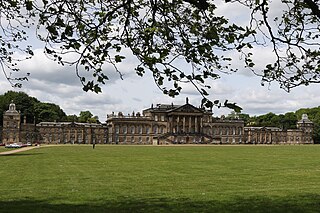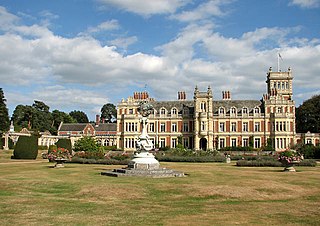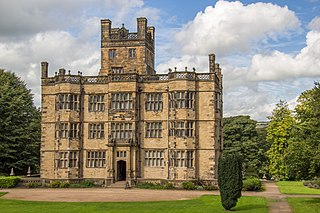
Peckforton Castle is a Victorian country house built in the style of a medieval castle. It stands in woodland at the north end of Peckforton Hills one mile (2 km) northwest of the village of Peckforton, Cheshire, England. It is recorded in the National Heritage List for England as a designated Grade I listed building. The house was built in the middle of the 19th century as a family home for John Tollemache, a wealthy Cheshire landowner, estate manager, and Member of Parliament. It was designed by Anthony Salvin in the Gothic style. During the Second World War it was used as a hostel for physically disabled children.

Wentworth Woodhouse is a Grade I listed country house in the village of Wentworth, in the Metropolitan Borough of Rotherham in South Yorkshire, England. It is currently owned by the Wentworth Woodhouse Preservation Trust. The building has more than 300 rooms, with 250,000 square feet (23,000 m2) of floorspace, including 124,600 square feet (11,580 m2) of living area. It covers an area of more than 2.5 acres (1.0 ha), and is surrounded by a 180-acre (73 ha) park, and an estate of 15,000 acres (6,100 ha).

Eaton Hall is the country house of the Duke of Westminster. It is 1 mile (2 km) south of the village of Eccleston, in Cheshire, England. The house is surrounded by its own formal gardens, parkland, farmland and woodland. The estate covers about 10,872 acres (4,400 ha).

Tabley House is an English country house in Tabley Inferior, some 3 kilometres (1.9 mi) to the west of the town of Knutsford, Cheshire. The house is recorded in the National Heritage List for England as a designated Grade I listed building. It was built between 1761 and 1769 for Sir Peter Byrne Leicester, to replace the nearby Tabley Old Hall, and was designed by John Carr. The Tabley House Collection exists as an exhibition showcased by the University of Manchester.

Somerleyton Hall is a country house and 5,000-acre (2,000 ha) estate near Somerleyton and Lowestoft in Suffolk, England owned and lived in by Hugh Crossley, 4th Baron Somerleyton, originally designed by John Thomas. The hall is Grade II* listed on the National Heritage List for England, and its landscaped park and formal gardens are also Grade II* listed on the Register of Historic Parks and Gardens. The formal gardens cover 12 acres (4.9 ha). Inspired by Knepp Wildland, Somerleyton is rewilding 1,000 acres (400 ha) of the estate to which he has introduced free-roaming cattle, large black pigs and Exmoor ponies.

Chillingham Castle is a medieval castle in the village of Chillingham in the northern part of Northumberland, England. It was the seat of the Grey and Bennett families from the 15th century until the 1980s, when it became the home of Sir Edward Humphry Tyrrell Wakefield, 2nd Baronet, who is married to a member of the original Grey family.

Gawthorpe Hall is an Elizabethan country house on the banks of the River Calder, in Ightenhill, a civil parish in the Borough of Burnley, Lancashire, England. Its estate extends into Padiham, with the Stockbridge Drive entrance situated there. The house is traditionally attributed to Robert Smythson. In the mid-19th century, the hall was rebuilt by Charles Barry, the architect of the Houses of Parliament. Since 1953 it has been designated a Grade I listed building. In 1970 the 4th Lord Shuttleworth gave the hall to the National Trust, with a 99-year lease to Lancashire County Council. Both bodies jointly administer the hall and in 2015 the council provided £500,000 funding for restoration work on the south and west sides of the house.

Dodington Park is a country house and estate in Dodington, South Gloucestershire, England. The house was built by James Wyatt for Christopher Bethell Codrington. The family had made their fortune from sugar plantations in the Caribbean and were significant owners of slaves. It remained in the Codrington family until 1980; it is now owned by the British businessman James Dyson.

John Jervis Tollemache, 1st Baron Tollemache was a British Conservative Member of Parliament, as well as a major landowner and estate manager in Cheshire. He was raised to the peerage in 1876 as Baron Tollemache, of Helmingham Hall in Suffolk.

Dorfold Hall is a Grade I listed Jacobean mansion in Acton, Cheshire, England, considered by Nikolaus Pevsner to be one of the two finest Jacobean houses in the county. The present owners are the Roundells.

Harrington is a village and civil parish in Northamptonshire, England, administered by North Northamptonshire council. At the time of the 2001 census, the parish's population was 154 people, including Thorpe Underwood but reducing to 146 at the 2011 Census. The Church of England parish church of St Peter and St Paul is located north-east of the village itself.
Peckforton is a civil parish in Cheshire East, England. It contains 21 buildings that are recorded in the National Heritage List for England as designated listed buildings. Of these, one is listed at Grade I, the highest grade, four are listed at Grade II*, the middle grade, and the others are at Grade II. The most important structure in the parish is Peckforton Castle, a Victorian country house built for John Tollemache in the form of a Norman castle. This, its chapel, and its entrance lodge are listed, as are a farm and cottages on the former Tollemache estate. The other listed buildings are all houses or cottages, and a large carving of an elephant and castle.
Bashall Eaves is a civil parish in Ribble Valley, Lancashire, England. It contains 22 listed buildings that are recorded in the National Heritage List for England. Of these, three are at Grade II*, the middle grade, and the others are at Grade II, the lowest grade. The parish contains the village of Bashall Eaves, and is otherwise rural. The most important building in the parish is Bashall Hall; this and structures are associated with it are listed. Most of the other listed buildings are houses and associated structures, farmhouses and farm buildings. In addition, three bridges and a public house are listed.
Hazel Grove and Bramhall are towns in the Metropolitan Borough of Stockport, Greater Manchester, England. The towns, together with the village of Woodford, contain 29 listed buildings that are recorded in the National Heritage List for England. Of these, one is listed at Grade I, the highest of the three grades, one is at Grade II*, the middle grade, and the others are at Grade II, the lowest grade. Most of the listed buildings are houses and associated structures, farmhouses and farm buildings. The other listed buildings include churches and lych gates, and two war memorials.
Alberbury with Cardeston is a civil parish in Shropshire, England. It contains 58 listed buildings that are recorded in the National Heritage List for England. Of these, one is listed at Grade I, the highest of the three grades, seven are at Grade II*, the middle grade, and the others are at Grade II, the lowest grade. The parish contains the villages and settlements of Alberbury, Cardeston, Wollaston, Halfway House, and Rowton, and is otherwise rural. In the parish the listed buildings include two ruined castles, two country houses and associated structures including lodges, and three churches and items in the churchyards. Most of the other listed buildings are houses, cottages, farmhouses and farm buildings, and the rest include the remains of a windmill, two milestones, a public house, and a war memorial. Three of the listed buildings are also Scheduled Monuments.
Atcham is a civil parish in Shropshire, England. It contains 67 listed buildings that are recorded in the National Heritage List for England. Of these, four are listed at Grade I, the highest of the three grades, six at Grade II*, the middle grade, and the others are at Grade II, the lowest grade. The parish contains the village of Atcham and the surrounding countryside. In the parish are three country houses; each of these is listed at Grade I, and they are associated with a number of other listed buildings in the surrounding grounds. The other Grade I listed building is the parish church, and items in the churchyard are also listed. The Severn River runs through the parish and the older bridge crossing it is listed. Also listed is a bridge crossing a disused branch of the Shropshire Union Canal. The other listed buildings include houses and cottages in the village and countryside, farmhouses and farm buildings, two milestones, and a telephone kiosk.
Blymhill and Weston-under-Lizard is a civil parish in the district of South Staffordshire, Staffordshire, England. It contains 61 listed buildings that are recorded in the National Heritage List for England. Of these, five are listed at Grade I, the highest of the three grades, and the others are at Grade II, the lowest grade. The parish contains the villages of Blymhill, Weston-under-Lizard, Brineton, Great Chatwell, and Orslow, and the surrounding countryside. Much of the parish is occupied by the country house Weston Hall and its estate, Weston Park. The house and many structures within the estate are listed. Most of the other listed buildings are houses, cottages, farmhouses and farm buildings, the earlier of which are timber framed or have timber famed cores. The other listed buildings include churches, memorials in the churchyards, and a public house
Wentworth is a civil parish in the Metropolitan Borough of Rotherham, South Yorkshire, England. The parish contains 82 listed buildings that are recorded in the National Heritage List for England. Of these, three are listed at Grade I, the highest of the three grades, eight are at Grade II*, the middle grade, and the others are at Grade II, the lowest grade. The parish includes the village of Wentworth and the surrounding area. The most important building in the parish is Wentworth Woodhouse, a large country house, which is described as "one of England's greatest and most remarkable houses", and is "celebrated for being the longest front of any English country house". The house is listed together with associated structures and items in its grounds. Most of the other listed buildings are houses, cottages, and associated structures, farmhouses and farm buildings. The other listed buildings include churches and items in churchyards, a public house, a former school with attached almshouses, a folly, a mausoleum and a memorial tower, two windmills converted into houses, bridges, a weir and a causeway, a milestone and a milepost, workshops and a forge, a junior school, a former mechanics' institute, a war memorial, and a telephone kiosk.














